|
Walsall
has many fine buildings in the town centre, one of which is
to be found at 29 Bridge Street. It was once well known to
musicians and music lovers throughout the Black Country as
Taylor’s music shop.
H. Taylor & Son, who ran the business, provided a service
that was second to none, selling a wide range of musical
instruments, for which tuition was available in one of their
music rooms, as well as full repair facilities in their
workshop.
The building, built in 1892, is well known for the finely
carved stonework on the façade which features musical
instruments and some of the leading composers.
It isn’t so well known that the carving was carried out by a
local sculptor, John Lea, who once taught at the Science and
Art Institute.
What follows was kindly sent by Mary and John Lea, who live
in Australia.
John is John Lea's great grandson.
The articles and photographs tell the story of
John Lea, and the lovely Bridge Street building, which was
Grade II listed on 31st July, 1986. |

An advert from 1899. |
|
John Lea of Walsall - Sculptor, Woodcarver,
Teacher of Modelling and Carving
Born in Walsall, in 1842, John Lea was the eldest child of
John Lea and Sarah (nee James). |
|
They
were licensees of the Roebuck hotel in Upper Rushall Street,
which had been in the family since the 18th century. John’s
Father was also a cabinet maker whilst his Mother worked as
an upholsterer. In 1856 John’s Father died at the age of 41
leaving Sarah with five children to care for.
At
the time of the 1881 census John, his wife Elizabeth
(Barlow) and their children were living at the ‘British Oak’
in Blue Lane East. John is listed as ‘Licensed Victualler’.
The 1891 census shows the family still living at the same
address although the public house is now called ‘Royal Oak’.
His occupation is shown as ‘Stonemason’.
John
possibly served his apprenticeship with Stone Mason, Isaac
Webb. The ‘South Staffordshire Illustrated Biographical and
Commercial Sketches’ (1899) noted John Lea had worked his
way up from Stone Mason's shed to being a teacher of carving
at Walsall Science and Art Institute.
The
Walsall Annual Red Book lists John Lea as a teacher between
the early 1890’s and 1903. In 1892 he was an Assistant
Master at Walsall Science and Art Institute and teacher of
Modelling and Carving at the Technical Day School for Boys.
In 1903 he was an Assistant Master at the school of Art and
a teacher of Modelling in Clay at the Technical Day School
for 200 boys. |
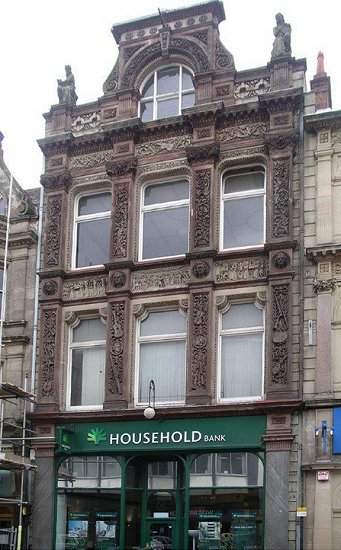
29 Bridge Street. Courtesy of John
Wallace. |
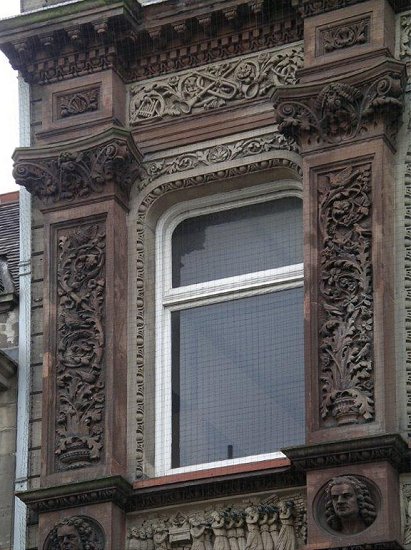
A close-up view of some of the fine
carving on the facade of Taylor's shop. Courtesy of John
Wallace. |
Taylor’s Music Shop, Bridge Street, built in 1892, was
designed by local architect Samuel Loxton (1830-1895), and
built Mr. William Wistance, of Walsall. The stonework
carving and sculpture work and interior woodwork were
executed by John Lea.
The facade features intricately carved panels featuring
musical instruments and foliage. Each bay has a frieze
carved with a biblical scene. The capitals are carved with
the heads of composers, Handel, Bach, Mozart and Haydn. At
the outer corners of the parapet are statues of Euterpe,
Goddess of Music and Melpomene, Goddess of Poetry.
In the centre of the two centre pilasters are two
bas-reliefs, one of the head of Beethoven and the other of
Mendelssohn. Inside the building the staircase is of pitch
pine, with handrail, balusters and newels of walnut. The two
principal newels are carved and surmounted with beautifully
carved walnut figures, one representing a travelling
musician, the other an acrobat. |
|
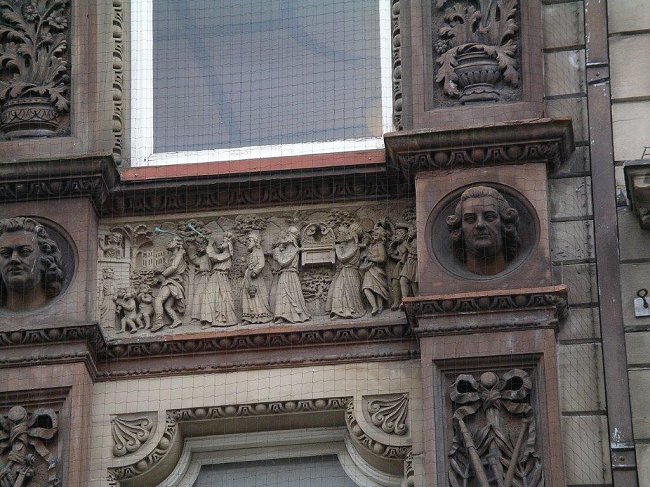
Another view of the carving. Courtesy
of John Wallace. |

Courtesy of John Wallace. |
The
Walsall Advertiser of Saturday December 24th, 1892 carried a
lengthy article, commenting on the erection of the building.
It describes John Lea as “the Modeller for the Walsall
School of Art and it reflects upon him the greatest credit,
not only with regard to his ability and his taste, but a man
of natural genius and rarely gifted, and we trust this
specimen of his work will be appreciated by acquiring for
him that due reward for its merit he so richly deserves.”
In
the early 1890’s at 33 Littleton Street he established a
Monumental Works with a show room, workshop and stable. A
sizeable dwelling house was erected in 1894. Much of the
work on the house was carried out by John Lea. Extensive
oak carving in the interior, whilst outside the front of the
house was principally of carved stonework. John Lea (junior)
also a Stone Mason (1872-1933) worked with his Father.
John’s wife Elizabeth passed away on the 31st December, 1901
and John died on the 25th October, 1903. He is buried in
Rushall churchyard.
The
house and business premises were demolished. The information
Centre for Walsall Leather Museum now occupies the site.
Taylor’s Music shop is listed by English Heritage as a Grade
II building. |

Courtesy of John Wallace. |

An advert from 1902.
|
There
are references to John Lea in several publications:
South
Staffordshire (Illustrated) Biographical and Commercial
Sketches. (1899) - see below
Mapping the Practice and Profession of Sculpture in Britain
& Ireland 1851-1951. (University of Glasgow)
Sketchbook Guide to the Black Country. Written and drawn by
Edmund Bealby-Wright (1996)
Public Sculpture of Staffordshire and the Black Country.
George T. Noszlopy and Fiona Waterhouse. (Liverpool
University Press (2005) Volume Nine) |
| After John Lea's death, his house was sold at
auction, as can be seen from the following, which
came from a newspaper cutting, kindly sent by
Mary and John Lea.
Valuable Monumental Works and
Residence, in Littleton Street West
Mr. Arthur J. Llewellen, at the
Stork Hotel, Walsall, on Tuesday, the 17th November,
1903, at Seven o'clock in the evening precisely
(subject to conditions incorporating the common-form
conditions of the Birmingham Law Society).
Lot l.
(John Lea, deceased.)
A valuable corner property,
known as the Littleton Street Monumental Works,
comprising handsome showroom and workshop at the
corner of the Wisemore and Littleton Street West,
Walsall; together with the dwelling house
communicating, and being Number 33, Littleton Street
West, and having a private entrance with stone wall
in front, until recently occupied by the late Mr. J.
Lea, sculptor and stonemason. The house contains
hall, entrance with vestibule, drawing room in front
(with handsome carved oak mantelpiece), large
sitting room (with bookcase and china cupboard
fitted), kitchen, and scullery, w.c. upstairs and
three bedrooms. One of the bedrooms is fitted with
an excellent wardrobe.
The front of dwelling house is
principally of carved stonework. There is a stable
and working shed at the rear of the property, with
gateway entrance, also side entrance to Wisemore.
The house and business premises
were erected by the late Mr. Lea, in 1894. The
property is leasehold for a term of 64 years
(wanting five days) from the 25th March, 1890, at
the annual ground rent of £4.7s. 6d.
Mr. T. Harrison Evans,
Solicitor, 45 Bridge Street, Walsall. |
|
| From the South Staffordshire,
Illustrated magazine -
Biographical and Commercial Sketches.
(1899)
Messrs. H. Taylor & Son, Musical
Instrument and Music Dealers, Bridge Street, Walsall
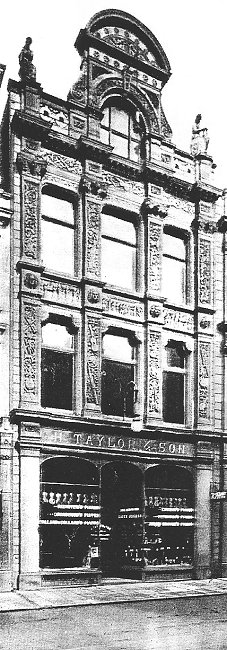 |
Amidst the stress of industrial activity
that pervades the busy manufacturing town of
Walsall, it is refreshing to discover such
evidences of refinement of taste that must
necessarily be implied in its possession of
one of the handsomest establishments
dedicated as a temple to the divine art of
St. Cecilia in the Kingdom.
This fine building of modern construction
was erected by Messrs. Taylor and Son to
replace the old premises in which their
business was founded half a century ago, and
which had become both too antiquated in
style and too cramped in space to provide
for the ever increasing requirements of
their widespread trade throughout the
Midlands.
The establishment, which forms a
conspicuous feature of the architectural
improvement of Walsall's principal
thoroughfares in recent years, is from the
design, and was erected under the
superintendence of Mr. Samuel Loxton in the
Italian renaissance style, and is of four
stories elevation and basement, each being
of the dimensions of 38 feet by 24 feet 6
inches, with additional building in the rear
used as a warehouse.
The facade is of unique design, and is
built of white Hollington and red Penkridge
stones relieved by granite. The ground floor
portion consists of two large windows, and
an arcade doorway laid with Minton tiles in
an effective pattern.
The windows and doorways are flanked by
granite pilasters two feet in breadth with
stone carved capitals. The next storey is
also relieved by pilasters of Penkridge
stone on which are carved musical
instruments. These pilasters support a
frieze on which are three deeply carved
panels, the central one representing David
playing before Saul; that to the right, the
Ark entering the Holy City; and to the left
the Fall of Jericho. At the sides of these
panels are carved heads of Handel. Bach,
Mozart, and Haydn. |
|
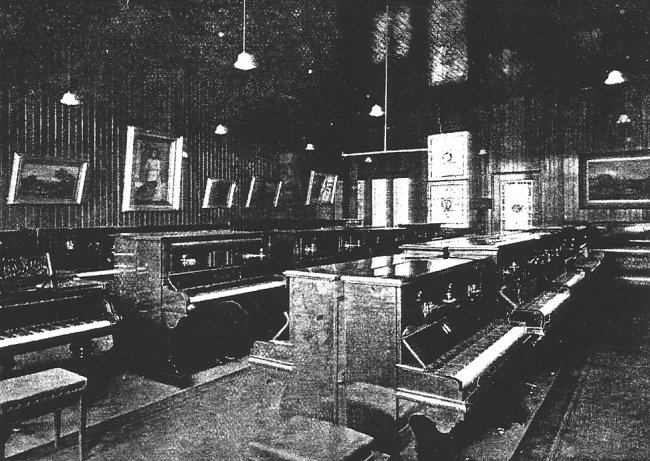
Showroom number 2. |
| These appropriate subjects are
harmoniously treated by the clever sculptor
Mr. John Lea, of local fame, who, it may be
incidentally mentioned, has worked his way
up from the stone mason's shed and is now
teacher of carving in the Walsall Art
Schools. The design of the upper stories
is perfectly in keeping with the portions
just described, the whole being surmounted
by a rich pediment, and at either coving the
coping is embellished by figures six feet in
height, one representing Euterpe, the
Goddess of Music; and the other Melpomene,
the Goddess of Poetry.
Before entering upon the details of
interior arrangement we may first invite
attention to the effective display in the
windows. That to the left of the entrance is
devoted to a show of pianofortes and organs,
and in front of these are tastefully
arranged copies of sheet music with their
artistic illustrations, and albums in
elegant bindings, including the latest
productions of the most eminent composers
and writers of the day.
The window to the right, of air-tight
construction, is appropriated with an
extensive assortment of smaller instruments,
including violins, both old and new,
mandolins, guitars, banjos, zithers,
accordions, concertinas, and every
description of requisite and accessory for
musical practice in each branch of that
diversified art. |
|
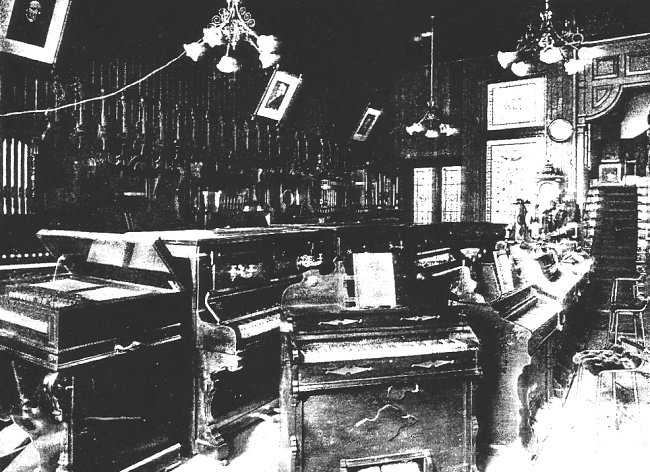
A view of the shop. |
| On entering the spacious interior the
visitor is at once cognisant of the dominant
note of the arrangements and appointments
throughout, the two newels at the entrance
to the staircase being surmounted by two
handsomely carved figures, one representing
a man playing a mandolin, and the other in
the pose of a dancer, while even the windows
in the rear of the saloons, and on the
staircase are of stained glass, reproducing
either musical instruments or characters
associated with some phase of the art. |
|
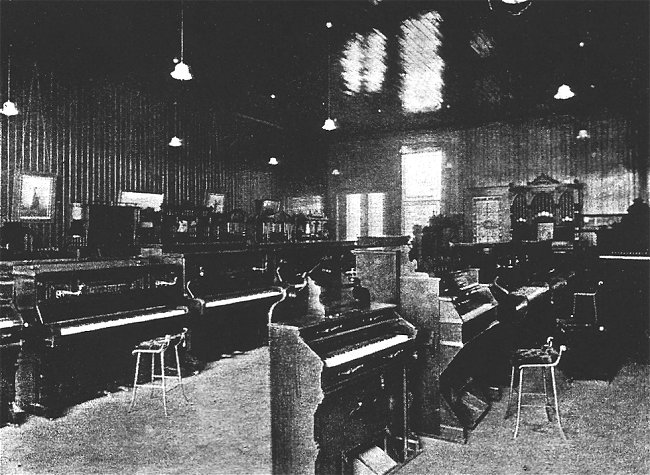
Showroom number 3. |
| A noteworthy feature in the ground floor
department is the immense collection of
violins, of which from 150 to 200
instruments form the average stock, which
includes some splendid specimens of the old
masters as well as the more modern makers,
of all sizes and sorts, ranging from 5 to 20
guineas. Zither-banjos are also very much
in evidence, and yet more so the pianos and
organs, which include such well known and
eminent makers as Messrs. Bechstein,
Steinway, Justin Browne, J. and J.
Hopkinson, J. Brinsmead, Broadwood, Rud,
Ibach Sohn, Collard and Collard, Kirkman,
Knauss, Schiedmayer, Russell, Eavestaff,
Hemingway and Thomas, Rowinski, and the
celebrated Brooklyn Pianofortes.
The last named instruments are an
especial success in Walsall and district,
being an excellent instrument at a medium
price in which are combined in an
exceptional degree all the qualities of a
good piano, together with a powerful tone,
light touch, and great durability. They are
of very beautiful design and are brilliantly
finished. Lining the passage leading to the
offices are cases for all kinds of
instruments, and at the end are the
apartments for the clerical and accountancy
staff. |
|

A view in the Workshop. |
| The firm, although doing an extensive
cash trade, having also established an
immense connection of hire purchase
customers on the three-years' system of
payment, a department that has developed of
late with leaps and bounds, necessarily
involving an enormous amount of
correspondence. |
| Ascending by the fine staircase to the
upper floor, we note three stained glass
windows with photographs of Beethoven and
Gounod, with Mendelsshon as a centre piece.
On this level are the music rooms, each
provided with a piano and other instruments
required by the Professor for giving lessons
to the pupils. Beyond this is the No. 2
showroom for pianos, of which large stocks
are on view by the makers whose names are
already given.
Ascending another flight of stairs, No. 3
showroom is reached, the principal feature
in this department being a numerous
selection of organs of various designs and
makes, among which are represented the
manufactures of Estey, Mason and Hamlin,
Story and Clark, Bell Organ Co., etc., the
prices of which vary from £5 to 125 guineas,
and in this room are also pianos of the
cheaper class at prices ranging from £8 to
£25, and second hand instruments that have
had a little wear but are still serviceable
for general purposes. |
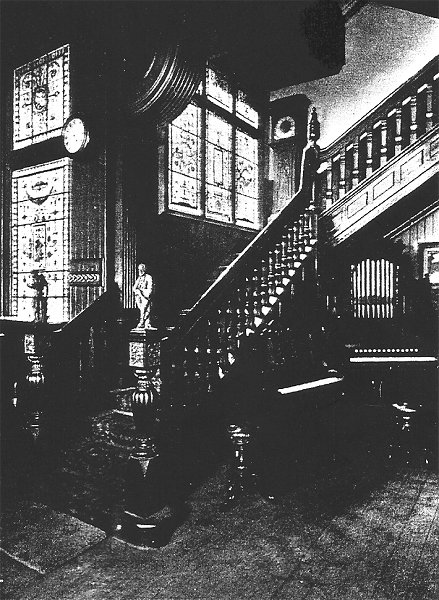
A corner of the
staircase. |
| The fourth storey is arranged as
workshops, wherein old pianos are renovated
and old organs restored to their pristine
condition; although the firm frankly
explains that the old-fashioned instruments
can never be made as good as the modern
ones, they can be turned out under skilful
treatment as perfect as when they first left
the factory. Here, also, repairs are
executed in violins, banjos, bows, etc., and
among the implements in use are massive
steel cramps for heavy repairing work to
pianos, and in contrast the lighter cramps
for violins and smaller instruments; in
fact, the equipment of this department, in
common with the entire arrangements of the
admirably organised establishment, are
completely well-ordered in every detail; “a
place for everything, and everything in its
place” being the mot d' ordre
throughout, the services of skilled London
workmen being employed, and the closest
personal supervision exercised by the
principals in each branch, commercial and
operative. |
|
|
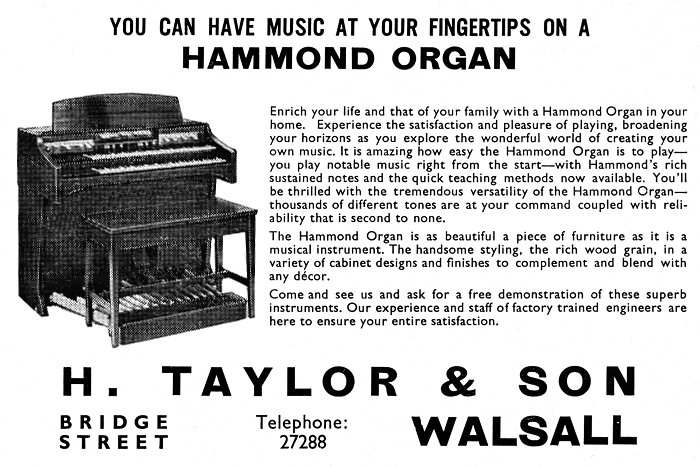
An advert from 1976.
| Views of the shop from July 2017: |

An advert from 1968.

 |
Return to
the
previous page |
|